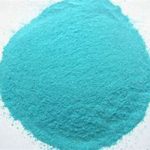Copper Glycine
Specifications
| Item | Index |
| Assay % | ≥99.0 |
| Cu % | ≥23.0 |
| Pb% | ≤0.001 |
| As% | ≤0.0005 |
Packing& Storage
| Packing | In 25kg bag. | |||||||
| Storage | 20℃, 2 years. | |||||||
| Shipping | Room temperature in China; may vary elsewhere | |||||||
General Information
1.1 Chemical & Physical Properties
| Common Names | Copper Glycine | Cupric aminoacetate | bis-glycinatocopper(II) | ||||||
| Structure |  |
||||||
| CAS No. | 13479-54-4 | Boiling Point (℃) | 1200 °C | ||||
| Molecular Weight | 211.663 | Melting Point (℃) | 1170 °C | ||||
| Appearance | blue crystalline powder | Vapor Specific Gravity | N/A | ||||
| HS Code | 2931900090 | Flash Point (℃) | >1200°C | ||||
| Solubility | insoluble in water | Autoignition Temperature (℃) | N/A | ||||
1.2 Safety Information
| Safety Phrases | S26-S36 | |
| RIDADR | UN2923 | |
| WGK Germany | 3 | |
| Packaging Group | II | |
| Hazard Class | 8 | |
| SYMPTOMS | PREVENTION | FIRST AID | |
| Inhalation | Cough. Sore throat. | Use local exhaust or breathing protection. | Fresh air, rest. |
| Skin | Redness. Burning sensation. Itching. | Protective gloves. | Remove contaminated clothes. Rinse and then wash skin with water and soap. |
| Eyes | Redness. Pain. | Wear safety goggles. | First rinse with plenty of water for several minutes (remove contact lenses if easily possible), then refer for medical attention. |
| Ingestion | Abdominal pain. Nausea. Vomiting. | Do not eat, drink, or smoke during work. Wash hands before eating. | Rinse mouth. Induce vomiting (ONLY IN CONSCIOUS PERSONS!). Refer for medical attention . |
1.3 Synthetic Route
Glycine is synthesized first. Using monochloroacetic acid as raw material and formaldehyde, ammonia mixed at less than 10 °C, and then rising to 30 °C, reaction 4H to obtain glycine. Glycine was prepared by chelating copper ions with basic copper sulfate and copper carbonate in the presence of copper ions.
